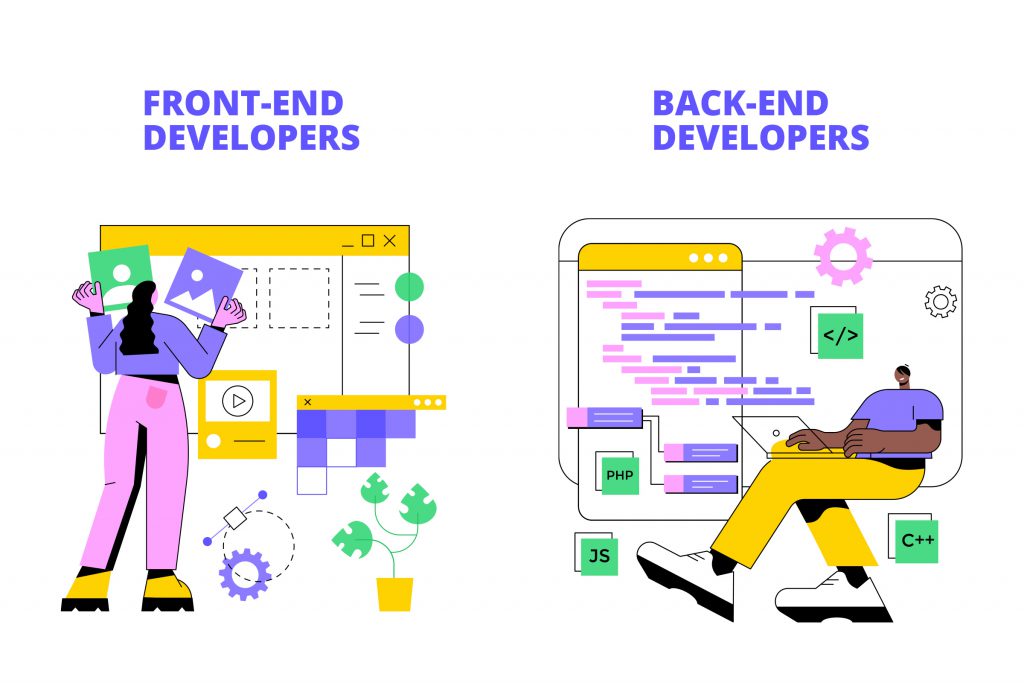Whether you’re developing a website or an application, you’ll need to hire both front-end and back-end developers–your first task should be to understand both front-end and back-end software development. Before you hire a front-end or back-end developer, though, make sure you know what front- and back-end software development is and why they’re necessary.
Unfortunately, some people proceed to hire their developer before they have an idea of what a front-end developer is. This is a recipe for disaster because, more often than not, they’ll end up hiring the wrong people. Proper development is critical because front-end development involves setting up design elements that your website users will see when they open the site, and if your back-end interface doesn’t work, your front-end user interface won’t work properly either.
In short, the two interfaces must work concurrently to enhance the overall appearance, navigation, and performance of your website; each interface must be developed by a professional who understands how it works. This is why it’s so important to understand the difference between a front-end and a back-end developer–only after you’ve understood what each developer does can you find the right people for your project.
What Is a Front-End Developer?
In web development, a front-end developer is a person who develops the user interface (UI). They’re responsible for ensuring that the people using your site or app can interact with it easily and effectively. The developer will come up with the layout and other design elements, ensuring that every part of the user interface has all the necessary elements placed in their rightful positions for easier access and navigation.
Your front-end developer will combine various designs, technologies, and programming languages to code your site’s appearance and handle debugging. The most common programming languages used for front-end development include HTML, CSS, and JavaScript. Each of these languages serves a specific purpose in making sure the user-facing parts of your site or app meet all the needs of your users.
For instance, the hypertext markup language (HTML) lays out the content and structure of a site or app, while the cascading style sheet (CSS) adds design elements to the UI. JavaScript builds advanced interactive features of the platform to help users interact with it easily and more effectively. Other common front-end development programming languages include Ruby, PHP, and Python.
A good front-end developer needs to understand how to use the various web-building frameworks and libraries, including jQuery, Angula.js, Ember.js, and Bootstrap to create a UI with well-organized content on different devices. Libraries are important for condensing codes into smaller and easy-to-use packages. In some instances, front-end developers are required to use graphic design tools like Sketch and Photoshop, as well as code editing programs like Eclipse and Notepad.
What Is a Back-End Developer?
A back-end developer is the direct opposite of a front-end developer since they’re only responsible for the parts of a website that aren’t accessible to the everyday user. They develop and maintain the tools that allow your website or app to process information and perform critical actions on the platform.
These mechanisms include security, data processing, data storage, and other server-side elements that aren’t visible to the user. They’ll also write codes that will serve as the base for your app or site. Back-end development of an app or website mainly revolves around the creation of server-side software that does everything that’s not visible.
For instance, your back-end developers will focus on databases, app programming interface (API), back-end logic, servers, and the overall architecture of the site. These tasks require exceptional coding skills because the developer has to write codes that will enable your visitors to connect with databases, understand, process, store, and remove data.
Back-end developers are supposed to be conversant with different programming languages, tools, and frameworks like Python, Java, Ruby, and more. They must use these tools and programs effectively to ensure that the back-end works responsively and rapidly to user requests.
The other role of a back-end developer is to make sure that the website or app meets your requirements and industry standards. Therefore, they must perform the necessary quality assurance tests. These tests create and oversee test schedules that optimize UI and user experience (UX), ensuring there’s maximum display on different devices and web browsers. Your back-end developer should assess the efficiency and speed of your app or website and adjust the code when necessary.
Although back-end and front-end developers have varying skill sets, they must collaborate to create a wholesome website or app. They should also work together with product managers, app and website testers, and principal architects to develop the right structure–the freelance developers on Guru are skilled enough to do just that. Find your perfect front- or back-end developer on Guru today!



